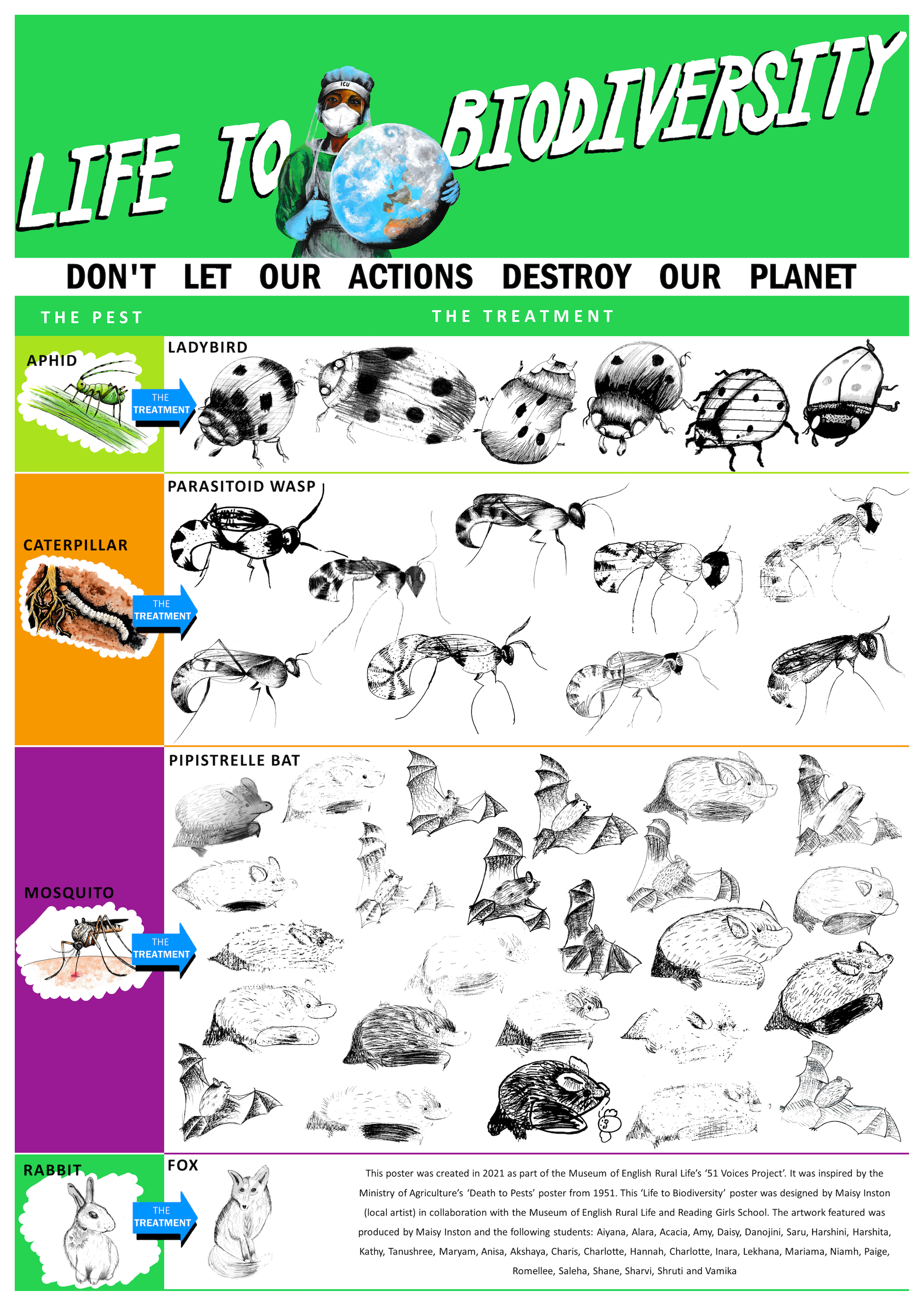
Life to Biodiversity
Life to Biodiversity is a collaboration by Reading based illustrator Maisy Inston and Reading Girls School as part of The MERL’s 51 Voices. The MERL’s collections provide fascinating insights into agricultural policy and practices, and Maisy selected the 1951 Ministry of Agriculture and Fisheries, Death to Pests poster, 1951 as the starting point for the 51 Voices collaborative artwork. The project ran over six weeks in early 2021, with around 50 student participants from years 7 and 8.
Maisy’s reflections
Life to Biodiversity flips the original Death to Pests poster on its head: instead of a soldier, there is an ICU nurse; instead of pesticides, there are pest controlling species. The artwork aims to show how in both 1951 and 2021, we can use our knowledge to protect our food security in the face of adversity. Through the nurse, COVID-19 has it’s stamp on the final piece and therefore provides a historical context.
The student sessions started with the historical context of the poster. I was fascinated to hear what the students thought about the poster and impressed by their knowledge and understanding. I gathered their initial ideas in the first session to help format and design the final piece.
The sessions then focussed on the ecology of pesticides. I created a batch of watercolour and fine-liner species illustrations on small cards. I then built and filmed card towers to display how human food security depended on multiple species. Again, I was very impressed by the student’s knowledge of the domino-effect issues that come with removing species from ecosystems.
Finally, sessions were held on artistic techniques. I shared my tips and tricks for drawing effective black and white animal illustrations. It was brilliant to see one student really engaging with the topic and providing artwork based on her own example of a pest and pest controller.
At the end of each session, I would run a drawing tutorial with a focus on three pest-controlling species: a seven-spot ladybird, a parasitotic wasp, and a pipistrelle bat. The students followed the instructions brilliantly and there was a really nice array and variety of shapes and styles. My aim was to ensure the students felt proud of their work and had fun, and making things photo-realistic came last.
Once all the sessions were complete I began building the final piece, mixing online software with acrylic paint. The meaning behind the title and banner was reversed to reflect a change in our understanding. The nurse was suggested by students when I asked what a modern day alternative might be to the solider. I think it accurately reflects how our view of the natural world has changed – instead of something to fight and conquer, we see it as something to protect and heal. It also adds historic value to the poster, providing, like the original, an insight into the events happening around this time. I then added watercolour and fine liner illustrations, including the student’s marvellous drawings as a suggested ‘treatment’. There were a disproportionate number of bats in the final piece, because everybody loves a bat.
Overall, the project has been immensely enjoyable, and I feel the final piece communicates the messages we discussed in the sessions. I hope that I have transferred my enthusiasm for the natural world and inspired the students to have a greater appreciation for the all the bizarre and over-looked species we share our habitats with.

With thanks to The MERL staff: Phillippa, Claire and Emma and all at Reading Girls School.
Life to Biodiversity was made possible through the generous support of Arts Council England and the Culture Recovery Fund. Although we’ve been unable to welcome our communities in to The MERL Galleries, we’re still #HereForCulture.
Visit the 51 Voices online exhibition.
